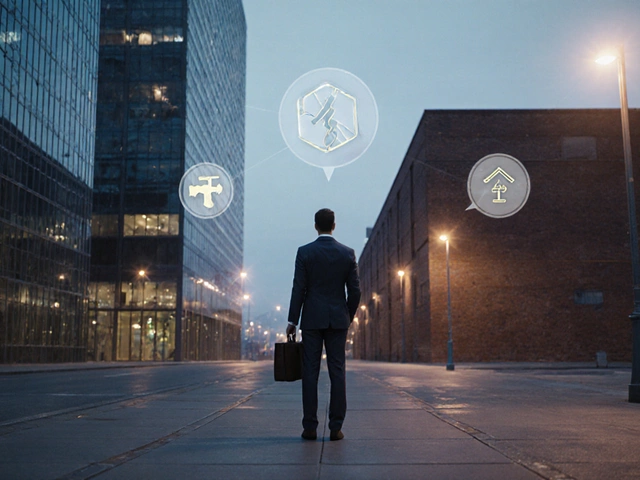Can You Claim Land in Utah? What to Know Before You Dream Big

People still daydream about stumbling on a wide-open plot in Utah, staking a claim, and calling it theirs—kind of like pioneers did. Truth is, that’s not how it works anymore. The days of grabbing land just because nobody was living on it are long gone. Utah’s laws and systems look nothing like the Old West, but the ideas persist. Still want land? You’ll need to know how things work now—or risk wasting time or losing money.
Most of the open land in Utah is actually government property. The Bureau of Land Management (BLM) holds almost two-thirds of it, and they don’t just let you fence it off. There’s no more homesteading, either. Congress shut down those programs in the 1970s, so you can’t get land for "free" just by living on it and improving it.
Private land is what you’re after if you want a legal deed in your name. It’s all about buying, not claiming. That's the hard truth nobody really tells you when you're scrolling land-for-sale posts online. And to be honest, plenty of scammers love the confusion. But don’t worry, there are real paths to ownership—if you know the rules.
- Utah’s Land: Public vs. Private
- Can You Really 'Claim' Land in Utah?
- Buying Land: How It Works in Utah
- Potential Pitfalls and Scams
- Tips for Finding Legit Land Deals
Utah’s Land: Public vs. Private
When you picture Utah, you might see huge stretches of open ground—mountains, red rock, empty valleys. But almost 70% of it isn’t up for grabs. Instead, it’s controlled by the federal government, mostly managed by the Bureau of Land Management (BLM). They allow all sorts of stuff—camping, hiking, grazing cattle—but you can’t just show up and claim it as your own. No matter what you hear, you can’t get a deed for public land, and the rules are even tighter in state and national parks.
Want to actually own a piece of Utah? That’s about private land, not public. Private land is owned mostly by other people, ranches, families, companies, or developers. That’s the land that goes on the market and gets listed with an agent or on land-for-sale websites. When you see a price tag, that’s your clue it’s privately held and actually for sale.
Here’s a quick breakdown of Utah’s land status:
- Public land (BLM, Forest Service, parks): You can visit, but you can't buy or claim it.
- Private land: You can buy, lease, or inherit it. This is the only land you can easily own outright.
- Trust land: Controlled by the Utah School and Institutional Trust Lands Administration (SITLA). Sometimes auctioned, but the process is stricter than private sales.
If you see “Utah land for sale” posts, always make sure you’re dealing with private land. No shortcuts or back doors on public property—it’s private land or nothing.
Can You Really 'Claim' Land in Utah?
So here’s the real scoop: you can’t just wander into Utah, toss a flag into some open field, and legally claim it as your own. The old wild west days of land grabs are long dead. Seriously, if you try, the federal government and local law enforcement won’t take it lightly—you could get fined or even arrested for trespassing. The idea of claiming free land mostly comes from old homesteading laws, but these ended for good in 1976 when Congress passed the Federal Land Policy and Management Act (FLPMA). No new free claims since then, anywhere in the U.S.
Most land in Utah is owned one of four ways:
- Federal government (mostly BLM or Forest Service)
- State government (like Utah State Trust Lands)
- Native American reservations
- Private landowners
Here’s a helpful look at who actually owns Utah’s land today:
| Owner | Percent of Utah Land |
|---|---|
| Federal Government (incl. BLM, Forest Service, etc.) | 63% |
| Private | 31% |
| State | 6% |
All those empty, beautiful places you see out the window? Most are managed by federal or state agencies. Even if it feels deserted, you can’t just move in. There's also no squatter's rights magic here—Utah makes it tough to claim land by living on it (what’s called “adverse possession”). The state requires you to pay property taxes, have actual possession for seven years, and show a color of title. That means you’d have to honestly think you owned it and do all the owner stuff already. Even then, this is rare and risky—it’s not how people get land in 2025.
If you see ads about free land or super-easy claims in Utah, be very skeptical. Always check county records and talk to the county clerk or assessor before you believe the hype. The only way to truly own Utah land now? You have to buy it, inherit it, or (very rarely) trade for it.
Bottom line: if your dream is to "claim land Utah," you’ll have to do it by the book—no shortcuts, no wild west style staking out territory. But knowing the facts will save you a lot of wasted effort and headaches.

Buying Land: How It Works in Utah
So, you can't just walk out and stake your claim, but you can buy land in Utah—if you play by the rules. Most land sales go through real estate agents, local listings, or auction sites. There's private land all over Utah for sale, from cabin spots in the mountains to desert plots down south. But it's not just find-it, pay-for-it, and move-in. There are some steps that matter a lot if you want to avoid headaches later.
First, figure out what kind of land fits your plans. Some land is zoned for houses, some for farming, and some for nothing at all. Zoning rules can make or break your dream, so always double-check with the county where the land sits. Also, don’t just eyeball the borders—get a survey. Boundary fights in Utah can get ugly and expensive real quick.
Buying land isn’t like grabbing a house. Usually, you’ll need cash or a hefty down payment, since banks aren’t as wild about land loans. Expect at least 20-30% down, and interest rates are almost always higher for land than homes. There are owner-financing deals out there, but always read the fine print, and never send money before seeing the land in person.
- claim land Utah: You'll need to buy land legally—there's no process to claim it just by showing up.
- Always check title history and make sure there are no liens (debts or legal issues attached to the land).
- Look for access—some properties look great on a map, but you can’t get to them by road. Utah has landlocked parcels where you might have to cross someone else’s property even to visit.
- If you plan to build, look up water rights and check for utilities. Water, especially, is a big deal in Utah’s dry climate. Don’t assume you can drill a well or tap into city water.
Here’s a quick breakdown to keep you straight on land-buying basics in Utah:
| Step | What to Watch For |
|---|---|
| Get a survey | Confirms boundaries—not just what the seller “thinks” they own |
| Check zoning | Keeps you from buying land you can’t use how you want |
| Title search | Uncovers liens or disputes |
| Water rights/utilities | Avoids surprises if you plan to build |
| Access | Guarantees you can actually visit/use your land |
One last thing: closing costs on land usually run lower than houses—often 2-5% of the sales price. But don’t skip your homework on taxes, HOA dues (yes, even for bare land), and future development plans. Some counties can assess big value jumps if you ever build.
Potential Pitfalls and Scams
If you’re thinking about snagging land in Utah, you need to watch out—this space is crawling with sketchy deals and straight-up scams. The most common trap? Sellers who pretend land is available to "claim," when it’s actually state or federal property. If you see promises like, “Just pay a filing fee to own this Utah land!” hit the brakes. That’s not how claim land Utah works and never has, at least not since the ‘70s when homesteading was actually legal.
Another one is the classic “ghost parcel.” Someone tries to sell land they don’t actually own, or that doesn’t exist on county records. Unsuspecting buyers wire money, only to discover later that someone else holds the deed, or the land is part of a nonexistent subdivision.
Watch out for crazy low prices. If a listing seems too good to be true, it probably is. Real land—even in rural Utah—rarely sells for pennies unless something’s seriously wrong. It could be landlocked (no legal access), in a floodplain, or the "seller" may have zero connection to the property.
Check out these common pitfalls buyers run into:
- Paying for a property without running a real title search
- Buying land that’s landlocked, meaning you can’t legally get to it
- Falling for fake auctions or sales with high-pressure tactics
- Trusting seller promises that you can "move in and make it yours" on public land
- Overlooking zoning laws that stop you from building, camping, or even parking an RV
If you want numbers, here’s a quick look at land fraud reports in Utah in the last few years:
| Year | Fraud Reports Filed | Estimated Losses ($ millions) |
|---|---|---|
| 2022 | 134 | 2.1 |
| 2023 | 181 | 3.4 |
| 2024 | 157 | 2.8 |
To protect yourself, always work with a real estate agent or attorney who knows Utah’s land quirks. Don’t skip due diligence—double-check everything at the county recorder’s office and get a title insurance policy. Scammers rely on rushed buyers. If you slow down and dig into the details, you’re way less likely to get burned.

Tips for Finding Legit Land Deals
Alright, if you're trying to snag your own patch of Utah, you’ve got to play it smart—especially with so many fake listings and sketchy sellers out there. Here’s how to keep your wallet (and sanity) safe while searching for real land you can actually own.
First, stick with licensed real estate agents or trusted land platforms like LandWatch or Zillow. If the offer sounds too good to be true—think $1,000 for 40 acres—hit pause. Real land in Utah costs more than that unless there’s a major catch (like no road access or impossible zoning).
- claim land Utah listings pop up all the time online, but check if the seller is legit. Look for a Utah licensing number or check the Utah Division of Real Estate's website for their name.
- Always verify who owns the land. County assessor records are public and free. Pull up the parcel number and see if the name matches your seller.
- Don’t skip an in-person visit. Google Maps might show a pretty view, but what if there's a giant gravel pit next door? It happens in rural Utah.
- Check the zoning. Every lot has rules about what you can and can’t build. Some lots are zoned only for grazing, so you can’t plop down a cabin or RV just anywhere.
- Watch out for "owner financing" deals that have crazy interest rates or hidden fees. If someone says you don’t need a title company, that’s a big red flag.
If you want to see what real estate values look like today in Utah, check out this quick data snapshot from early 2025:
| County | Avg. Price Per Acre (USD) | Typical Zoning | Public Land % |
|---|---|---|---|
| Salt Lake | $42,500 | Residential, Commercial | 15% |
| Iron | $7,400 | Rural, Grazing, Agricultural | 68% |
| Uintah | $2,800 | Resource, Industrial | 73% |
| San Juan | $3,100 | Rural, Recreational | 87% |
The best deals show up in more rural counties, but those are also where folks get ripped off most often. It helps to talk to local people or even real estate attorneys if anything feels off. Make sure you see every document—deed, survey, tax bill—before you hand over any cash.
Bottom line? Take your time, double-check everything, and don’t let anyone rush you. The right land deal is out there, but only if you look past the hype and stick to the facts.









Write a comment